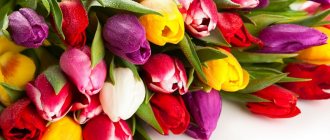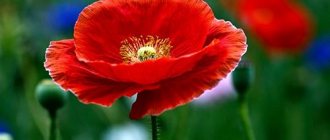Author: Nadezhda Bushueva
Flowers and their meaning is quite a broad and very interesting topic. Flowers accompany us everywhere, every day we see them in shop windows, in flower beds, in fields and meadows. They bring them to us as a gift, expressing their feelings without words. In the East, a wonderful tradition has emerged of presenting flowers for the holiday, as a sign of appreciation and gratitude. Each flower has its own meaning, its own language and symbol. The language of flowers came to our country around the 17th-18th century, but acquired its own meanings and symbolism that corresponded to our traditions and characteristics. This topic attracts me with its mystery and ambiguity, and I think you, my dear readers, will also be interested.
History of the language of flowers
The language of flowers as a concept arose in the East, namely in Turkey, where the Selam system has long existed, used in versification, where with the help of one word, the name of a flower, one could depict or reproduce a phrase or line that spoke of feelings.
Later, this system became the main foundation for the emergence in Europe of such a concept as the language of flowers. Using the language of flowers, you can confess your love, break up, quarrel, exchange pleasantries, etc., all you need to do is select suitable flowers and plants and send them to the recipient as a message or note.
This was originally done in Turkey, and this idea became fashionable in France in the 18th century, everyone wanted to try to express their feelings through symbols, meanings and the language of flowers. In Paris, a special book was even published on this topic, which was popular and was called “The Language of Flowers,” which indicated the meanings of popular flowers and anyone could use them to express their feelings.
Later, this trend came to Russia and a book on this topic was also published in St. Petersburg. It was called “Selam, or the language of flowers.” The author of the book was the poet Dmitry Petrovich Oznobishin. This book was very popular at the beginning of the 19th century among young girls who were compiling home albums and adding various dried flowers, field or garden, which spoke about the feelings of the owner of the album in a symbolic language that young ladies of that time successfully used.
The beginning of the 20th century pushed the language of flowers into the past, and only almost 100 years later new interest in this topic appeared.
New in blogs
The language of flowers appeared in the East, in particular in Turkey. In this country there was a system that made it possible to reproduce a poetic line that spoke of feelings using one word. Plants were often used as keywords. The system was called selam.
It became the basis for the emergence of the “language of flowers” in European culture, which was very popular at the end of the 19th century. Skills in such a language began to fade by the middle of the 19th century. In our country, a surge of interest in entertaining floral cryptography arose relatively recently - at the end of the 20th century. Therefore, it is worth returning to the original sources - the books that served as reference books on the language of flowers at the beginning of the 19th century.
Fluorography
Floral language, like any other, has changed over time and adapted to the conditions in which it was used - after all, each locality has its own favorite flowers. Sometimes the symbolism of the flower changed and did not coincide with its original eastern interpretation. For example, phlox had two interpretations - it could mean submission and consent, but at the same time it was a symbol of fiery passion.
Fluorography
Fluorography is a science that reveals the meaning and symbolism of various flowers and plants. Simply put, it is the language of flowers, with the help of which they express ideas, feelings, and moods.
During the Victorian era, the language of flowers was very helpful in cases where feelings could not be spoken openly, but required secret expression. Floral arrangements were created from fresh flowers (plants), wreaths, bouquets, and multi-colored objects or painted objects were used. Not only flowers were involved in the language, but also their arrangement, even the tilt of the flower mattered.
Fluorography
These flower dictionaries have come to us; they tell in detail about the meaning of many plants.
In Russia, the popularization of the language of flowers is associated with the name of the poet and translator Dmitry Petrovich Oznobishin, who published the Persian book “Selam, or the Language of Flowers” that he translated into Russian. This book described more than 400 plants, each of which had a specific word or phrase. The book was quite popular, of course, primarily among young people.
Fluorography
Nowadays, when giving a bouquet that carries such a message in the language of flowers, you risk remaining misunderstood. Perhaps you should include a short “flower phrase book” with your bouquet? You can include a book on the language of flowers with your gift so that your flower letter can be deciphered. Or simply complement your greeting card with an interpretation of some of the meanings of the language of flowers.
Azalea
Azalea is a symbol of femininity, fragility, meekness, restraint, devotion; but at the same time - passions and sadness. It is customary to give azalea before an unwanted separation. When presenting an azalea, you say “I hope you will wait for me,” “Take care of yourself for me,” “I believe you!” When a man gives this flower, he admits that you are the only one for him.
Acacia
Acacia - secret love, chastity, loneliness. Acacia is a flower of regret and recognition of one’s mistakes. The one who gives the acacia says: “You are the best thing that happened in my life,” “Why aren’t we together now?”, “Let’s start all over again!”
Alstroemeria
Alstroemeria - makes a gentle compliment to the one to whom the flower is given, saying: “You are so sweet!” or “You are lovely!”
Adonis (adonis)
Adonis (adonis) - denotes an enthusiastic attitude towards the one to whom the bouquet is given.
Anemones
Anemones - sincerity, hope; but also joy, emotionality. Translated from the language of flowers, a gift of anemones means: “Why not?”, “I feel very good with you,” “Let’s have a party?”
Anthurium
Anthurium - courage, originality, passion. Anthurium is considered a predominantly male flower. A bouquet or composition with anthuriums will be an unforgettable gift for a husband or colleague, friend or boss... You can also give anthuriums to an extravagant lady, a kind of “vampire woman,” if you want to tell her: “You are unlike anyone else, and this delights me.” .
Aster
Astra (white) - in “flower language” this means “I love you more than you love me!” It is a symbol of love and grace, as well as memories.
Pansies
Pansies - nowadays these flowers are rarely given as gifts, but in the language of flowers they mean fun and entertainment.
Basil
Basil - although it is a spice, it also has its own meaning: disgust, hatred. If for some reason you cannot tell a person you don’t like everything you think about him, give him basil.
Bouquet of dried flowers
A bouquet of dried (dried) flowers means rejected love.
cornflower
Cornflower - “I don’t dare express my feelings to you”; delicacy, grace, simplicity, as well as gaiety and loyalty. It is customary to give cornflowers to young girls as a sign of sympathy. Such a gift may mean an offer of friendship or a desire to renew an interrupted acquaintance. The giver of cornflowers should not be suspected of immodest desires. For some reason, blondes most often like cornflowers.
Water lily
Water lily (water lily) - to pick such a flower, you will have to remain wet, but confidently declare your eloquence, sincerity and persuasiveness. And also say “Feelings are raging in my soul.”
Gardenia
Gardenia - secret love, “You are beautiful.” If you were given a gardenia, you should know that you are sincerely admired. Most likely, your admirer is very timid and considers himself unworthy of you.
Carnation
Carnation means charm, passion, fidelity, female love, honor. It is also worth noting that the color of a carnation carries different meanings. For example, if they wanted to say “I won’t be with you,” they gave a striped carnation.
Hibicus
Hibiscus - in the language of flowers it means long and eternal love.
Dahlia
Dahlia is a whim, inconstancy, a passing hobby. The person giving dahlias says: “I really like you, but I don’t promise anything,” “I’m not ready for a serious relationship,” “Why complicate everything?”
Gerbera
Gerbera - mystery, smile, flirtation, optimism. The person giving gerberas expresses his sympathy for you and hints that you will have a lot of fun together. Gerbera is a universal positive gift: for friends, lovers, colleagues... Feel free to choose these flowers if you want to share your excellent mood with someone or give a compliment.
Gypsophila
Gypsophila - caution, timidity. However, in a mixed bouquet, gypsophila, as a rule, is a kind of accessory, serves to give volume to the flower work and does not carry a semantic load.
Hydrangea
Hortensia - “Remember Me”; modesty, sincerity, hope. Many peoples believe that hydrangea has the ability to ward off illness and misfortune.
Gladiolus
Gladiolus - “I am truly sincere”, “Fear nothing”, flower of gladiators. The giver of gladioli is a strong, reliable person who does not accept compromises.
Gloxinia
Gloxinia - I don’t know what kind of flower this is, but I liked the meaning - it means love at first sight.
Delphinium
Delphinium - modesty, unpretentiousness; "I'm ready to be your shadow", "Call me"
Jasmine
Jasmine - sensuality, femininity, elegance and attractiveness. In India, jasmine is called “moonlight in love.”
Honeysuckle
Honeysuckle means affection, true love, dreams of a happy future. According to another interpretation, in the language of flowers, honeysuckle can symbolize generosity and generosity.
Iris
Iris - “I value your friendship very much” and symbolizes hope, trust, faith.
Calla
Calla - in the language of flowers, balance. Now this language has become more advanced due to the expansion of the plant’s color range. Burgundy and pink callas are a sign of admiration and recognition, classic white callas are a symbol of meekness, golden yellow callas speak of restraint and devotion; Purple calla lilies in a bouquet are an image of greatness, but at the same time - passion and sadness. “You are magnificent,” says the man with such a bouquet to the woman to whom he presents it. And at the same time, many consider callas to be a male flower. Maybe this is due to the shape of the flower and its strict appearance. However, the leaf shape of this plant is heart-shaped. You can say that calla leaves are filled with warmth from the heart. The inflorescence of this flower is, as it were, wrapped in a long beautiful leaf, which gives callas such an elegant and recognizable appearance.
Camellia
Camellia - admiration, perfection, gratitude. "You are an unearthly being."
Bell
White bell - humility, submission, constancy; “I will always be with you,” “Why do you torment me with whims?”
Blue bell – Constancy.
Crocus
Crocus - means affection, fun, joy. But in the language of flowers, when giving a purple crocus, you can ask, “Do you regret that you fell in love with me?”, When giving a yellow crocus, you can ask, “Are your feelings true?”
Cactus
Cactus - symbolizes perseverance or constancy. It may hint at the giver's fruitless attempts to achieve reciprocity.
Clover
Clover is considered a symbol of happiness; the one who gives it wishes happiness to the one who received the bouquet, or hints to him that he makes him happy.
Lavender
Lavender - admiration, loneliness. “I will never forget you”, “No one will replace you.”
Laurel
Laurel - Triumph, eternity, glory.
Lily of the valley
Lily of the valley - In Ancient Germany they were a symbol of reciprocity; lilies of the valley were considered a guarantee of love and happiness in family life. What could be simpler and at the same time more beautiful than lily of the valley? A few white, porcelain-like bells on a long stem and a pair of light green leaves - that’s all; and yet how beautiful it is, how elegant! And how beautiful it is in a bouquet surrounded by a border of its leaves! In Germany and France, they still celebrate the lily of the valley festival every year on the first Sunday in May and organize dances. Girls attach a bouquet of lilies of the valley to the bodice of their dress, and guys attach it to the buttonhole of their coat. When a guy invites a girl to dance, the girl exchanges bouquets with him as a sign of agreement. In the past, a bouquet of lilies of the valley had a deeper meaning: it expressed the consent of young people to get married, and this evening usually ended with the announcement of who was marrying whom.
Levkoy (Matthiola)
Levkoy (Matthiola) - Unfading beauty.
Lily
Lily is a symbol of tenderness, fidelity and cloudless happiness. The magical aroma of these flowers improves your mood and gives you a feeling of celebration. A bouquet or arrangement of lilies is a wonderful gift for an affectionate, romantic girl. Lily is one of the undisputed favorites of the flower world. This flower has an inimitable delicate aroma, which since ancient times has been identified with the aroma of tenderness and love.
Lily (orange ) - curiosity, coquetry. “You are a mystery to me,” “Is your heart free?”
Lily (white) - purity, purity, majesty, nobility. “It’s divine to be next to you!!!”
Lily (tiger) - pride, abundance, prosperity, well-being, arrogance.
Palm leaves
Palm leaves - if you decide to decorate the bouquet with these leaves, you will wish them success and good luck.
Lotus
Lotus - means health and happiness.
Magnolia
Magnolia - nobility, perseverance, perseverance, “You will still be with me,” “I am your destiny.”
Poppy
Poppy - speaking in the language of flowers, it will mean dreaminess, youth, imagination. A poppy picked in the field says “I’m dreaming of you,” a poppy in the garden says “Let’s love each other while there is time.”
Mallow
Malva - means a request for leniency, the hope of being noticed or forgiven.
Mimosa
Mimosa - hiding their feelings, speaking the language of love, they announced: “I am hiding my feelings.”
Daisy
Daisy - means true love, purity, innocence.
Narcissus
Narcissus - contrary to legend, in the language of flowers, narcissus means attention, chivalry. The yellow flower said “You are the only one”, “When I am with you, the sun always shines.”
Forget-me-not
Forget-me-not - with this flower you can express fidelity, true love, and talk about your memories.
Nivyanyk
Nivyanik - personifies the innocence with which the donor asks not to remain indifferent to his feelings.
Marigolds (calendula)
Marigolds (calendula) - report anxiety, uncertainty, jealousy.
Dandelion
Dandelion - it is unlikely that a man will choose this flower for a bouquet, but even if he takes a risk, it will hint that he is happy and faithful.
Orchid
An orchid is a luxurious flower and means beauty and love. And it is also considered a Chinese symbol of childhood. It is customary to give orchids only to loved ones.
Fern
Fern - in the language of flowers, means magic, charm, grace, mystery, enchantment, as well as the secret shackles of love.
Peony
Peony - in the language of flowers, means a cheerful life, a happy wedding and, in contrast, compassion.
Pelargonium
Pelargonium - promises support, consolation or a request to be close.
Snowdrop
Snowdrop - when giving the first spring flower, say “You are not like everyone else,” and it also means tenderness and hope.
Sunflower
Sunflower - this sunny flower is the main symbol of optimism, fun and prosperity. In the language of flowers, a bouquet of sunflowers given to a girl means: “You are a miracle!”, “I have never met someone like you,” “I am proud that you are with me.” Sunflowers are the sunniest flowers. A bouquet or composition of sunflowers is a bright, original and unforgettable gift. It is recommended to give sunflowers to creative and extraordinary people. Opt for a bouquet of sunflowers if your goal is to improve your mood, apologize or make a positive impression.
Rose
Rose - oh, how many of them have already been given! It turns out that there is a difference in what form you give it: a bud means an innocent heart; lethargic - you did not make an impression; dried - “Better death than living without happiness.” Color also plays a role: red speaks of love, dark red - mourning.
Rose (red) - love, passion. “I love you”, “I can’t live without you”, “You should be mine.”
Rose (bud, red) - “I think I’ve fallen in love with you,” “I’m glad we met,” “Every day my feelings for you are getting stronger.”
Rose Grand Prix - respect, generosity, love, trust, “You deserve the best.” Rose Grand Prix expresses the most noble feelings.
Rose (white) - purity and innocence, modesty and tenderness, mystery. “I will get you”, “You are an angel”.
Rose (yellow) - happiness, joy. "You are my sun". A flower that expresses the most positive emotions. According to the language of flowers, yellow roses have nothing to do with betrayal and jealousy (although this interpretation of their symbolic meaning is very common).
Rose (cream) - elegance, harmony, perfection, constancy. "I remember. Always!”, “You and I are the perfect couple”, “You are beyond praise!”
Rose (pink) - the highest happiness, “Trust me.”
Chamomile
Chamomile - many girls like this simple flower; it is believed that where a star falls, a chamomile blooms. And its name comes from the Latin word “romana”, which means “Roman”. Daisies are cute and simple flowers, warm and familiar. The color scheme of these flowers is yellow-white, yellow-green; these colors mean cheerfulness and happiness. Chamomile is a symbol of sweet simplicity and tenderness, a symbol of fidelity and a symbol of Russian nature. A bouquet of daisy flowers, so similar to wild ones, will be a wonderful gift for any event.
Lilac
Lilac - if white, it will mean first love, purple - “My heart belongs to you.”
Strelizia
Strelitzia - victory, masculinity, originality, determination. Strelitzia is considered the flower of strong, brave and successful people.
Tulip
Tulip is a symbol of spring and eternal youth. According to floral etiquette, it is one of the most sophisticated and, at the same time, universal gifts. You can give tulips to both women and men of any age and social status. Nowadays, tulips and tulip bouquets are considered the most popular and versatile floral gift. They are the main symbol of hope, youth and spring. In Turkey, the tulip is the main symbol of love and eroticism. Turkish women are sure that a bouquet of tulips in their hands or a decoration with a picture of a tulip attracts the attention of the chosen one, lights his heart with love and fills him with the desire to urgently leave the ranks of bachelors. In the language of flowers, a yellow tulip means “Your smile is like sunlight,” a red one means “Trust me,” and a variegated one means “Beautiful eyes.”
Violet
Violet means modesty, innocence, dignity. The white one says “Let’s take a risk?!”, the blue one says “Careful!”.
Freesia
Freesia - trust.
Phlox
Phlox - “Let's burn our letters!”, parting; but also reciprocity, unity, sweet dreams.
Chrysanthemum
Chrysanthemum - yellow means fragile or rejected love, white means truth, red means good luck and best wishes.
Rose hip
Rosehip - in the language of flowers means spring and poetry.
Cyclamen
Cyclamen - resignation, “Goodbye”, “How tired I am of you...”
It is believed that the number of flowers in a bouquet has a certain meaning: one flower is a sign of attention, three is a sign of respect, five is recognition, seven is love...
The most important thing to be guided by when choosing flowers is, of course, the tastes of the person for whom you are choosing a bouquet. How to recognize them? Give flowers more often, and sooner or later, you will definitely hit the mark!
The language of flowers and the rules of giving
The language of flowers is not clear to everyone and is quite complex, but I think everyone will appreciate flowers given from the heart. The interpretation of colors in different traditions and countries is not entirely similar, but there are still common meanings and rules.
This is how it is customary for men to give flowers on a long stem: roses, gerberas, gladioli.
It is recommended to give a young girl delicate light flowers: tulips, daisies, etc. It is better to give a mother red roses or an elegant bouquet of her favorite flowers.
White flowers are suitable for the bride. For older people, it is better to give bright or light flowers in a bouquet or gladioli. Tulips, roses, carnations and gerberas are suitable for all occasions. Wildflowers are not suitable for anniversaries and official holidays.
It is customary to give carnations on Victory Day and February 23rd. It is best to give children small bright flowers or bouquets. It is appropriate to give indoor flowers to your beloved women, for example, orchids.
The flower horoscope according to the zodiac signs can be read here.
When buying flowers for a certain person, it is best to choose those that he loves, but if you do not have such information, choose flowers with love and the desire to please the person and then you will definitely like the flowers.
Symbolism of white color
Color-border, “non-color” (nothing or something before any beginning), daylight. White is the sum of all light. In the atmosphere it is the sum of colors, and its decomposition produces a rainbow. White is a symbol of purity, innocence, and naturalness. It emphasizes the idealism of character and the desire for perfection. This is the color of eternity and deities. Sufis (Islamic ascetics) associate the color white with the secret of inner light.
If you are dressed in all white from head to toe, then be careful not to look too “hospital” or create the impression of emptiness and infinity. White is often associated with absence, with something non-existent (“white crow”, “white spots”, “white ticket”...). It seems to symbolize anticipation: wedding, baptism, and so on. Reluctance to give up white in clothing may indicate a fear of leaving adolescence.
Flowers and their meaning by bud color
As a rule, the language of flowers is associated with certain human qualities. There are many legends and myths about the meaning and symbolism of certain flowers. Sometimes they are quite contradictory, but no less interesting. Particular importance is given to the color of the bud.
In our time, for example, the red color of a flower, as in the 18th century, means passion and strong love, in addition, red is the color of the royal nobility. This means that it would be appropriate to give them for an anniversary, for a celebration, as a symbol of nobility, recognition and honor.
White flowers are a symbol of chastity, purity and signify the pure intentions of the giver. White flowers are often presented at a wedding as a symbol of the beginning of a new stage in life or a relationship with a clean slate. White flowers do not scream about passion, but speak about sincerity and pure love.
Yellow flowers are suitable for friendship and devotion, and also signify wealth. The pink hue signifies affection and the beginning of a relationship, or simply courtesy and gratitude.
Cream shades – perfection and elegance, signify consistency and harmony. This color is neutral and suitable for many occasions.
Blue flowers speak of stability, dignity and nobility and constancy. Blue flowers are lighter, more romantic, but cold, they speak of spiritual purity and can mean faith and hope for the future.
Purple flowers are mysterious and majestic; they are a symbol of success and are presented to people who have achieved universal recognition: politicians, artists or creative people.
Orange flowers speak of warm feelings and express the best wishes, warmth and joy from the meeting.
What does the poppy flower symbolize?
According to Feng Shui, the poppy flower has various meanings:
- A symbol of great, faithful, happy love. The flower helps people meet, find their soul mate, and preserve love. If lovers have lost trust, quarrel, or move away from each other, a faithful talisman will help them get closer and feel each other again. Place a vase of flowers or paintings of poppies in the family nest.
- It symbolizes fertility, as it helps women find the long-awaited happiness of motherhood. A painting with the image of red poppies, embroidered with your own hand, will become a strong amulet.
- Helps improve relationships between parents and children. Gives you the opportunity to understand each other, listen, trust, and not quarrel. Has the ability to bring good luck in your career. With its help, you can become more successful, more purposeful, and more confident in moving towards your goal.
- He knows how to open his eyes to everything that is happening, point out the dishonesty of people, the absurdity and unnecessaryness of any actions.
- Symbolized victory, the blood of dead and wounded soldiers during the war.
poppy flowers
Meaning of iris
Iris is a well-known perennial, modest and unpretentious, has many names and meanings, for example, in Russia they were called cockerels and iris, and these flowers have been known since the time of Hippocrates and are named after the ancient Greek goddess Iris. Mythology tells us a story when the goddess Iris descended to people along the rainbow to communicate the will of the gods. Since then, the iris has become a symbol of good news and the connection between two worlds: heaven and earth.
In Japan, the iris is considered a masculine flower and is a symbol of honor and courage. And in the modern world, the meaning of a flower determines the color of its buds. The white iris is a symbol of purity and innocence, and the purple one is of wisdom and intuition. A bouquet of irises symbolizes respect. Blue irises symbolize masculinity, while yellow irises express admiration.
It is interesting that the iris petals are tender, and the leaves are sharp, sword-like. In Japan, this combination did not go unnoticed, and there iris signifies courage and warrior spirit. In Christianity, the iris, along with the lily, is often found on icons of the Virgin Mary, but unlike the lily, which means purity and purity, the iris symbolizes the sadness and pain of a mother about her son, but this refers to blue flowers.
In general, irises are very loved in monasteries and are grown there everywhere as a symbol of protection and purity. Irises are varied in their colors and attract attention with their mystery and ambiguity.
Poppies in the garden - the joy of change
Poppy is a wonderful annual that sows itself, and by bringing a pinch of these seeds into the garden you will forever bring unprecedented colors into your world, the joy of change every day, because when you wake up you never know what flowers await you today - after all, yesterday’s ones have already left, leaving silk of petals on the ground, and stable bright flowering for more than a month and a half. But all this is a rather boring explanation of why you need annual poppies or poppies, because especially for you we have prepared a completely different story about these flowers.
If you think that the rose is the queen of symbolism, then you are mistaken. The poppy and only the poppy is the king of symbols.
What have you heard about poppy? That he is a symbol of death and sleep? Yes, this is the most replicated image and symbol associated with this flower. But our research will go further and deeper so that you will forever fall in love with the variety of these flowers.
Poppy is a flower that is complex and simple at the same time. And the symbols that he personifies are just as different - simple and complex.
Let's start with the difficult ones.
In the famous koan (lesson) Dogen Genze “Manifestation of the Primordial Essence” it is written about the poppy as follows: “since the work of this flower is our teaching, and the Buddhadharma has established a way to deny the transformation of birth into death, then its flowering is a birth, which is understood as - no birth . Accordingly, death is understood as - there is no death, poppy is life and death in its variability and transience and complete absence. According to Buddhist legend, poppies grew on the ground that was touched by the eyelashes of the sleeping Buddha.
In China, poppies symbolized retirement, relaxation, beauty, success, but as a source of opium - decay and evil. Collecting poppies from Chinese poets in a figurative sense showed a lack of will to fulfill obligations, an inability to fulfill what was promised.
And Diogenes, in his treatise “On Nature,” called the poppy a symbol of unfading female youth and charm. He said that “she who grows poppies will never grow old in the eyes of a man.”
The soporific properties of poppy were well known in ancient times. This flower is an attribute of Hypnos. He was depicted as a lying or sitting youth or angel with lowered wings, carrying poppy heads in his hands, sometimes with a wreath of poppy heads on his head.
And of course, he was a constant accessory of the god of death - Thanatos, so he was depicted as a young man with a wreath of poppies, but with black wings, in a black robe and extinguishing an overturned burning torch.
It is interesting that the ancient Greeks and Romans also compared the poppy with a human head: the Greeks sometimes called the poppy - kodeion, and the human head - kodeia, and the Romans, in general, called Numa (similar to Homo?) and instead of the human heads sacrificed to Jupiter, they began to sacrifice poppy heads heads.
What do you think - what flowers were sown in the dream kingdom of the god Morpheus? Of course - poppies. The temple and statue of the goddess of fertility and marriage - Hera (Juno) on the island of Samos were decorated with poppy heads.
Who is depicted with a poppy in his hand in all the paintings and sculptures of ancient Roman temples? The goddess of the harvest is Ceres (the Greeks have Demeter). Wreaths were woven from poppy flowers and ears of grain to decorate her statues.
Do you remember how Demeter suffered when her daughter Persephone was stolen from her? To reduce her suffering, she surrounded herself with bouquets of poppies - for people this became a symbol of nature’s winter sleep.
- If in a dream you inhale the aroma of poppy seeds, then during the day in reality you will become a victim of false persuasion and flattery.
- If you dreamed of a blooming poppy, then all your pleasures will soon surround you, but this will be short-lived and fragile.
- If in a dream you saw poppy seeds or ate some dish with poppy seeds, then you will soon have an opportunity that will require you to show your foresight.
In Russia, church domes are often called golden domes. Do you remember that the upper part of the domes is called the crown?
This word, meaning “top, crown,” originally referred only to the head of the poppy flower. The transfer of meaning occurred due to similarity; at first the word crown meant only the head of a poppy.
Ukrainian witches-molfarks always cast their spells using the self-sown poppy with white flowers; it was collected in the evening (which seems impossible in reality, because after noon the poppies begin to shed their petals, and by 15-16 o’clock you will not see color on the poppies), on the night of the growing Moon, and always in the palm of the right hand. According to their beliefs, to attract love you need to carry a few poppy seeds in your pocket.
Poppy is a talisman against various evil spirits and is included in a variety of amulet bouquets.
It is enough to sprinkle any house with poppy seeds - and all the machinations of evil spirits, witches, and molfars will be ineffective. Only for this it must be consecrated in a head or bouquet on St. Macovea, that is, on the day of the Maccabean martyrs, August 1 (such a joint pagan-Christian holiday).
In Britain, in Yorkshire, there is a famous folk song about girls, in which the poppy is called “blind blow”, because the bright red color of the poppy is blinding, and “weak head”, because. the smell of its flowers gives me a headache.
The French call the poppy the flower of angels because... it is used to decorate churches on the day of the Descent of the Holy Spirit. On this day, small children dressed as angels walk in procession in front of the priest carrying the Holy Gifts, and strew poppy flowers on the road in front of him.
In general, think about the best when you bring poppies into your garden. It will always protect you from bad things, and of course, it will make the design of your garden an unpredictable fireworks display.
Bright and colorful poppies create an incredibly beautiful living carpet. This flower, whose scientific name is papaver (from Latin papa - father, baby porridge, and ver - real), is one of the oldest crops growing in Asia (Anterior and Eastern) and Southern Europe. Also poppies (today there are more than 70 species) can be found in North America, Australia and even in the subtropics.
Peony meaning
Peonies are beautiful and delicate flowers with a surprisingly pleasant smell and have their own special meaning in the language of flowers, not just one, but even several. There were legends about peonies in ancient Greece, where it was considered a symbol of longevity and healing.
In China, these flowers are especially valued. Peonies in the land of the rising sun are considered the imperial flower; it symbolizes wealth, nobility and prosperity, it is revered and idolized. In addition, peonies personify fiery love and are presented to loved ones.
Peonies are also a symbol of spring, rebirth, and the awakening of emotionality. White peony means chastity and modesty; such flowers can be given to young girls and brides on their wedding day. Pink peonies – romantic tenderness, caring and love. Red and burgundy peonies are considered a symbol of prosperity, respect and power.
Symbolism of gray
A moderate color, between black and white, everything and nothing. Gray matter is the brain. “Exercise your gray matter” in colloquial language means to think. “Gray life” is a life without bright events. The color embodies passivity. It is a symbol of respect, indifference, modesty, indecisiveness and neutrality.
In professional life, it reflects seriousness and efficiency when combined with the other. If you wear only gray, it will evoke sadness, fear, the approach of death, cold, monotony, and make you think about worse times. A person wearing gray is, as it were, erased in his own shadow: gray and shadow are identified.
Sunflower meaning
Sunflowers, in my opinion, are a symbol of joy, happiness, positivity, and longevity. This little sun is in our hands, this cute flower has positive energy and carries only positive emotions. The history of the origin of sunflowers goes back to ancient times, to North America, where Indian tribes began to grow them. And Peter 1 brought sunflower seeds to Russia.
The sunflower always turns towards the sunlight, despite the location of the luminary, hence its name, and one of the meanings is expectation and faith in the future. Subsequently, breeders developed a decorative sunflower flower, which is sold in flower shops and is often used in bouquets.
The bright yellow color represents friendship and hope; it seems to say: you warm me, thereby expressing gratitude. The Latin name for the flower comes from the Greek words sun and flower. What does folk wisdom say about this flower?
A bouquet of sunflowers personifies friendship, gratitude and, by giving it, they wish well-being and happiness in the family. In addition, by placing sunflowers at home, you will thereby clear the space of negativity, and by planting these sunny flowers in the garden or in front of the windows, you will protect yourself and your home from losses, failures and unkind people.
It would be appropriate to give a sunflower to a friend to lift his spirits, to an elderly person with wishes for longevity, etc.
Additional characteristics of poppy according to Feng Shui
Attracting career success is another unique and distinctive property and meaning of poppy. He, like no one else, is capable of promoting success in any field and in any service.
The plant especially favors those who are engaged in their own business. It will help minimize all risks, thereby increasing the chances of business prosperity.
Business people should grow this flower in their dacha and keep the photo on a shelf or table.
What else can poppies do? They have quite strong energy, which they willingly share with people.
Thanks to it, you can gain self-confidence, become more purposeful, successful, sociable and energetic. This will greatly help people with low self-esteem who are used to going with the flow.
It’s hard to believe, but thanks to poppies, they change in a very short period of time, experiencing positive metamorphoses.
This is how an amazing and beautiful plant, the poppy, helps people. One has only to turn to its influence, and life will change right before our eyes, becoming more interesting and better every day.
Aster in the language of flowers
At first glance, it may seem that the aster is an unremarkable flower, but this is not so, because translated from Greek it means “stars” and the inflorescence of an aster, especially a needle-shaped one, looks like a celestial star. These star flowers are widespread in Europe and beyond.
There is a legend that speaks of Jupiter, who was angry with people and sent a flood to the earth, but the goddess Astraea was very sorry for the people, she cried bitterly and her tears falling to the ground turned into unusual flowers, which were later called asters. Therefore, sometimes asters mean sadness and sadness.
There are other legends about asters, they are no less interesting. For example, that an aster grew from a small particle that fell to earth from a star. In Greece, asters were considered magical flowers that could drive away misfortunes, hardships, and misfortunes from the home.
Another meaning of the aster is security. In the language of flowers in the modern world, asters and their meaning have changed and mean patience, the desire to change certain events, or to show admiration.
Asters can be given to young girls and women as a compliment, or to apologize for something, to ask for forgiveness. Asters are like stars, give them to your loved ones as an amulet for good luck, as a gift from the gods, as a piece of a star, unattainable but beautiful.
Place for poppies
Feng Shui does not provide strict limits regarding the placement of poppies in the house. Here everything, for the most part, is limited to ordinary logic.
Do you want to attract love or improve your relationship? Hang the picture in the bedroom (preferably close to the bed).
If poppies sparkle with their colors on the bed linen in your bedroom, this is only for the better; this effect has a much stronger meaning than paintings.
Images should also be placed in other rooms, for example, in the living room or dining room, if you want to resolve quarrels and misunderstandings with your family.
A study, office or other room where business is conducted or a career is built should also not be left without the attention of poppies.
Today there are many different options for paintings with poppies, which will come in handy even in the most serious establishment.
Of course, keeping live poppies at home is very problematic, so either grow them in the garden if the house is private, or enjoy bright and high-quality sketches by artists by purchasing their paintings.
By the way, paintings are not the only option for finding Feng Shui poppies in your home. Now you can buy wonderful wall stickers, decorative items in the shape of a poppy, or come up with something yourself.
Feng Shui will only limit flights of fancy to a ban on dead or dried flowers. But beyond this there are plenty of options.
By letting poppy into your home, you will never be disappointed. At a minimum, because even this plant itself is very optimistic and charges you with cheerfulness and a light attitude towards life. It will easily fit into any apartment interior. And the multifaceted character and properties that never cease to amaze and delight will prove to be an excellent addition for the owner of this flower.
Pansies
Pansies and forget-me-nots are among the most famous symbols of the language of flowers. The English word pansies, “pansies,” comes from the French pensées, “thoughts.” By the 16th century, this association was already well-established: for example, in Shakespeare’s play Hamlet, the mad Ophelia lists flowers and herbs with symbolic meanings familiar to the audience: “Here is rosemary, this is for remembrance; I ask you, dear, remember; but the Trinity color is for thoughts.” Trinity color is one of the names of pansies in Rus'.
Latin name: Viola spp.
Meanings: I think about you; fun; think about me; lightness of heart.
Habitat: garden.
Colors: blue, as well as many other colors; often the coloring resembles a face.
Musk cornflower paired with pansies says to a lover, “I’m thinking about our forbidden love.” American pioneers believed that bringing a bouquet of pansies or violets to a farmhouse in the spring would bring prosperity to the family.
Symbolism of yellow
Yellow is the color of positive energy. It stimulates the ability to concentrate, enhances the gift of communication, and gives a feeling of lightness. This is the color of the sun, soothing warmth. Symbolizes spiritual light, knowledge, science, dynamism, hopes of youthful forces, as well as intellectual qualities, insight, cheerful disposition and freedom.
In Egyptian mythology, the heat and rays of the sun were considered the golden seed of the god Ra. In Islam, yellow is the color of betrayal and disappointment. Gold is the metal of Christianity. The color yellow is present on the Vatican City flag. Stones: sunstone (heliolite), tiger's eye. This is the color of the 3rd chakra: a symbol of self-respect, self-confidence, power, authority.
Symbolism of pink
Pink is a very positive color, symbolizing seduction, purity, and devotion. This is a symbol of femininity and love.
This color also has an aspect indicating relaxation and can symbolize the joy of life, a period of success. See life in pink: be joyful, look optimistically into the future. Pink color is romanticism, modesty, timidity, gentleness. It is an emblem of the divine, associated with Venus. This is a symbol of tenderness and delicacy.
Pink color expresses sympathy, responsiveness, but also the search for safety, affection, protection. Writer Barbara Cartland preferred to wear pink clothes, put on pink makeup, use pink objects in everyday life, and so on. Pink was her thing! She achieved success in literature, but was also known for her eccentric gait. She always wore airy pastel pink and caramel pink suits.
Color looks brilliant only in a certain environment, just as eyes only smile on a face. Ludwig Wittgenstein, philosopher
Snowdrops
Snowdrops have been a favorite flower in English gardens since Elizabethan times. As they are one of the few species that bloom in winter, it is hardly surprising that snowdrops have come to represent hope. For some authors, for example Robert Tyas, they also mean consolation: with their appearance, snowdrops promise that spring will come, comforting and delighting us at the end of winter. Indeed, in French the snowdrop is called perce-neige, “piercing snow.”
Latin name: Galantus nivalis.
Meanings: friend in adversity; comfort and hope.
Habitat: forest.
Colours: white and green.
The mysterious magical plant "moth" in Homer's Odyssey, used as an antidote to the potion of the sorceress Circe, may have been the snowdrop. This plant actually contains the substance galangamine, which is used to treat Alzheimer's disease and helps improve memory.
According to legend, when Adam and Eve were expelled from the warm paradise straight into winter, an angel turned some snow flakes into snowdrops to give people hope that spring would eventually come.
The Latin name Galanthus means "milk flower".
The English word snowdrop has the same root as eardrop (an obsolete word for earlobe).
Daisy
The daisy is one of the most common and well-known wild flowers. The name in English, daisy, is a corruption of the phrase day's eye, that is, “eye of the day”: the flower opens at dawn, and the underside of the petals is painted a soft pink color, as if reflecting the color of the sky at dawn. Shelley called the daisy a constellation flower that never sets. A comparison of daisies, scattered in abundance in the grass, with constellations appears in many other writers and poets.
In the language of flowers of the 19th century, the daisy signified innocence. According to writer Robert Tyas, it is a child's flower. Daisies are plentiful and easy to find, and the name often appears in nursery rhymes and games. Children wove wreaths from daisy flowers by splitting the stem of one flower with their fingernails and pulling the stem of another into the resulting hole. This simple watercolor captures the humble beauty of the daisy surprisingly accurately.
Latin name: Bellis perennis.
Meanings: beauty, fun, faith; I will never tell; innocence, fidelity, purity, simplicity.
Habitat: lawns, meadows, dune hollows, river banks.
Colors: Each petal, white with a pink tip, is an individual flower. The heart of a daisy is actually made up of many tiny yellow flowers.
The English word daisy comes from the expression "eye of the day", reflecting the way a flower opens to the sun and closes towards the night.
Daisy is a common diminutive version of the name Margaret: in French, the subspecies of the daisy is called marguerite.











